|
Art influences real life, which then influences art, and so on. It's a fact that the visionary scientists who finally brought man into space were fueled by the science fiction visionaries of their youth, men like Jules Verne and H.G. Wells. And the cycle continued. Many of today's inspirational science fiction creators were driven by the space progam of their youth - most notably the quest to reach the Moon. The cycle will no doubt continue. Science fiction and science fact are firmly interlinked. This portion of our site is dedicated to vehicles of the real life space programs - both historical and those currently tossed into orbit and beyond. As with science fiiction, the garage kit revolution opened new doors for real space modelers. There are now more and better kits than ever before. If you have any images of space hardware kits you'd like to share, please contact us! We need your help to make this area of the site grow. A good place to start with historical space modeling is Space in Miniature 1.1: The New Scale Spacecraft Primer. For more images of non-fiction spacecraft, check out our Readers' Gallery.
|
First Steps |
Project Apollo |
Space Stations |
Satellites |
Contemporary Space Programs |
X-Planes
Real Space Model News |
Links
|
First Steps |
![[And so it begins ...]](sput_ln.jpg) Image: Novosti/AP via NY Times |
Soviet Firsts. Four months before the first successful US satellite launch, the Soviets put the world's first artificial satellite into low earth orbit. The poetically named "Sputnik" (Satellite) shocked the West and galvanized the US into supporting a space program. It led to the foundation of NASA, the moon landings, and ultimately the wired world we live in. Not bad for an 84 kg (183lb) ball containing two radios and a power supply. In the meantime, the first US attempt to launch a satellite, the US Navy's Vanguard, blew up. It wasn't until January 31, 1958 that the US got off the starting line with the US Army's Explorer I satellite. The Soviets continued setting firsts, sending bigger rockets with bigger payloads into orbit. Then, on 12 April, 1961, they put the first human in space: Senior Lieutenant Yuri Alexeyevich Gagarin aboard Vostok 1. |
|
References: |
Reviews:
|
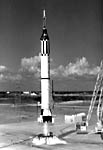 Image: NASA |
Project Mercury. With Project Mercury, the United States began its manned spaceflight program. Using a one-man capsule riding atop a Redstone missile, the project began by lofting primates into space. On May 5, 1961, Alan B. Shepard rode vehicle MR-3 over the Atlantic to become NASA's first rocket-boosted man-in-space. Two manned flights later, the project upgraded its booster to use the stronger Atlas missile. This allowed the US to finally catch up to Gagarin's Vostok flight by putting Lt-Col John Glenn to into orbit, on Feb. 20, 1962. After Glenn, three more astronauts would fly in Mercury capsules before NASA shifted its focus to the next phase of manned spaceflight: Project Gemini. |
|
References: |
Reviews:
|
![[First US spacewalk]](ed_white_eva.jpg) Image: NASA |
Project Gemini. The Gemini program was the intermediate step between America's first steps into space and the moon landings. Twelve spacecraft were launched between April 1964 and November 1966, all but two of them manned. The project accomplished a lot of firsts: the first astronauts to actually maneuver their craft in space were aboard Gemini 3; the first American space walk occurred during Gemini 4. Docking maneuvers and longer EVAs were part of later flights, all intended to gear the US astronauts up for Project Apollo and landing on the |
|
References: |
Reviews:
|
|
Project Apollo |
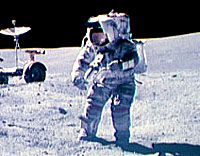 Image: NASA archives 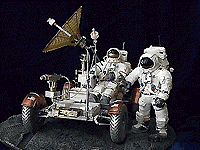 Image: Courtesy of EVA Models |
"THAT'S ONE SMALL STEP FOR A MAN, ONE GIANT LEAP FOR MANKIND." The national effort that enabled Astronaut Neil Armstrong to speak those words as he stepped onto the lunar surface, fulfilled a dream as old as humanity. The six Apollo missions that landed on the moon brought back a thousand pounds of lunar samples and a wealth of other scientific data. In all, 12 American astronauts left their footprints in the lunar soil during Project Apollo. Three additional lunar landing missions, Apollos 18 through 20, were canceled after a series of congressional budget cuts even though the required hardware had already been constructed and paid for. The spacecraft had three parts: A Service Module (SM), a Command Module (CM), and a Lunar Module (LM). The SM contained the principal propulsion system of the spacecraft, propellant, electrical system, water, and other supplies. The CM and SM flew together as a unit until the end of the Lunar round trip, when the SM was jettisoned prior to atmospheric entry. The module in which two of the three crew descended to the moon is the LM. Beginning with Apollo 15, the US' lunar epxpeditions began carrying the Boeing-built LRV (Lunar Roving Vehicle), or just "Lunar Rover" as it was commonly referred to. This lightweight buggy, rolling on four independently-driven piano wire mesh wheels, expanded the area astronauts could cover during their EVAs. In addition to providing tool and specimen storage, the Rover mounted a TV camera which could be remotely operated by Houston controllers. This enabled Earthside personnel to view what they wanted on the moonscape and allowed them to capture the stunning final Apollo lunar liftoff of Apollo 17's LEM ascent stage. |
|
References: |
Reviews:
|
|
Space Stations |
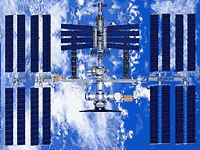 Image: Image of finished station. |
International Space Station After years of false starts, fluctuating budgets, and revised ideals, the International Space Station is finally under construction. This opens a new era in humanity's presence in space - one of grand constructions and international cooperation. The assembly of this large orbital complex is the most excitinging thing to happen since Crippen and Young took the untried Columbia off the pad in 1981. It's no Orbital Hilton, but at least the world will have another space station by the time 2001 rolls around. |
|
References: |
Reviews:
|
|
Satellites and Space Probes |
![[TO infinity ... and beyond!]](real_voyager.gif) Image: NASA. |
Voyager Launched just over two weeks apart in late 1977, Voyager 1 and 2 were the second set of space probes to explore the outer planets and space beyond our solar system. Far more sophisticated than their predecessors, the Voyagers greatly increased our knowledge of the outer planets, and are widely considered the most successful of NASA's interplanetary missions. Both probes are now travelling beyond our solar system and are expected to continue transmitting data until their nuclear-powered generators run out of fuel in the early part of this century. |
|
References: |
Reviews:
|
|
Contemporary Space Projects |
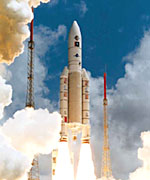 Image: Ariane 5 daytime launch. |
Though the great Space Race has ended (at least for now), space exploration and operations continue. The "space club" continues to gain members as new nations, and even private organizations, launch ambitious programs. Russia and the United States have long enjoyed a monopoly on manned space flight, but that is now changing as China and private firms like Virgin Galactic (SpaceShip One) and SpaceX (whose Falcon V rocket will be the first American system since the Space Shuttle to be man-rated, if all goes well) are entering the arena. |
|
References: |
Reviews:
|
|
X-Planes and other Research Craft |
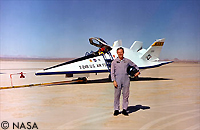 Image: NASA's X-24 verified lifting body theories |
Achievements in space could never have occurred without extensive research here on Earth. Until the 1970s, experimental planes (designated in the US as "X"-planes, for "experimental") were the chief research tools for flight regimes that wind tunnels, simulators and production aircraft could not approach. Even with sophisticated computer modeling, it is still necessary to build scale models and flying prototypes to test things in the real world. |
Modeling:
Reference:
|
![]()
Go back up | Starship Modeler Home | Site Map | Feedback
This page made possible by Starship Modeler - © 1997-2015
Last updated on 28 August 2015.